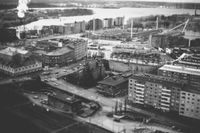Recent Posts
The Radial Ball Bearing
Posted by on

Radial ball bearings are precision-engineered components. Between at least two concentric bearing races is an array of hard stainless steel, chromium steel, or ceramic balls. The radial ball bearing comes in a sealed unit with the balls captured within machined grooves inside the rings which serve as a housing. (Counter to common usage, the term "ball bearing" refers to the entire bearing unit, not the individual steel balls).
- The central race is a disk that attaches to a rotating shaft or hub. When the central disk race is rotated, the motion is transmitted to the balls which in turn transmit the motion to the outer race.
- The motion transmitted by the balls is counter to the motion of the central disk race.
- If another layer of balls and outer ring race is added, the direction of the outer ring will be the same as the inner disk.
The purpose of the radial ball bearing structure is reduce overall rotational friction and support radial and axial loads. The ball bearing exchanges torque power for the reduction in friction. The balls contacting the rims of the concentric races transmit the motion with a very small near point-sized surface area because of their spherical shape. The loss of torque can be mitigated by increasing the number of balls in the mechanism.
Another advantage of some radial ball bearings is that it can buffer small misalignments between the angle of the driving disk and the outer rings. To some degree the system can be self-aligning.
Some Radial Bearing History
Roller bearings are an ancient invention. However, the first modern ball bearing system was patented in 1794 by Welsh inventor, Phillip Vaughn. Vaughn's design had the balls running within a grove machined into the axle assembly. A French bicycle mechanic, Jules Suriray designed the first radial style ball bearing in 1869. This radial bearing design helped to win the first bicycle road race that year.
Some Types of Ball Bearings:
- The Wingquist self-aligning ball bearing holds the balls inside a shell curved in two directions so that the axis of the inner race can tilt appreciably. This type of ball bearing allows for some tolerance for misalignment of the inner and outer races.
- The axial ball bearing holds the balls in a fixed square track so that force on the inner race parallel to the bearing can cause misalignment failure.
- Radial ball bearings are the most common bearing type. These ball bearings have deep grooves in the inner and outer races. They transmit more torque than the less grooved versions, but misalignment can be an issue much sooner than with the deeper groove bearings.
- Ceramic hybrid ball bearings weigh nearly half as much as the steel balls. These bearings are functional at 50% higher rotation rates than the common bearings. The outer race exerts less force inward as the bearing spins, reducing friction. The lighter balls use less energy to maintain speed.
- Ball bearings also vary by the kind of flanges and containment that surround the balls. Some radial bearing are open, meaning the balls are held by the groove in the races but are open on the sides. Others are closed flanged bearings meaning that the entire bearing is held in a sealed unit.
Radial and Thrust Loads:
Ball bearing can be used to allow rotation around a shaft perpendicular to the bearing itself. As the bearing turns forces are acting on it. For example, if the bearing is in the wheel of a car, the force is mainly in the direction of the rotation and causes the bearing to roll. These are called radial forces. If the bearing is supporting the seat of a piano stool, allowing the stool to turn, the forces are pressing down perpendicular to the bearing. Those forces are called thrust forces. Most ball bearings are designed to handle both kinds of forces. However, some ball bearing designs favor one kind of force or the other.
Carnell Sales, which operates the bigbearingstore.com outlet is becoming one of the largest distributors of bearings and power transmission components on the internet. Please contact us to see our catalog.

